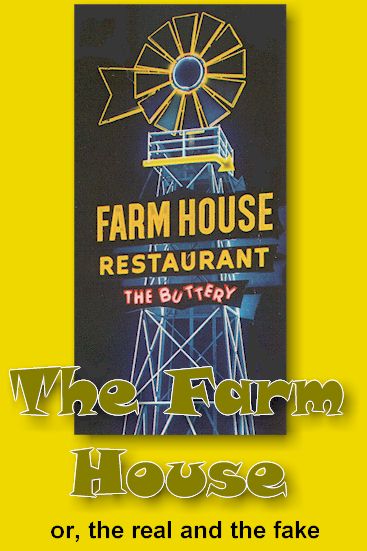
My first clue that there was a major disconnect between the real thing and California's version of it was in a visit to Massachusetts and New Hampshire that Mom and I took in 1968, when I was twelve. We toured the Fairbanks House, the oldest standing timber frame house in America, built circa 1636. As I looked in the various rooms I noticed that the furniture didn't look anything like the Colonial, maple-finished stuff Mom bought. Where were the sofas with the inn signs and eagle patterns? Why were there no pictures of red barns and covered bridges on the walls? No period bric-a-brac? No rooster weathervane lamps? Significantly, Mom put the place securely into a reference I could understand: she told me that Fairbanks Family of Dedham, Massachusetts were distantly related to the actor Douglas Fairbanks, and Mom would be happy to send the caretakers a photograph of the Fairbanks grave in Hollywood when we got back home. (She never did. And the actor Douglas Fairbanks was born Douglas Elton Ulman, and was not a Fairbanks in any way, shape or form - as a Fairbanks family member told me 33 years later.)
Plymouth Rock was pretty underwhelming, too. It was helpful that somebody had carved "1620" in it, but it was just a rock. And later I would learn that the first Anglo-Saxon Thanksgiving celebration in America took place in Virginia, not Massachusetts.
Sooner or later, most of us ask ourselves, what is reality? To a person raised in Southern California, the answer is simple: nearly perfect weather year ‘round; a perpetually youthful-looking population; expensive cars old and new with no rust; restaurants in the shape of bowler hats, hot dogs or ice cream cones; Main Street in Disneyland and fifty-foot high neon windmills along the interstate.
I recall a large neon windmill at the Farm House, a restaurant in Buena Park. It was pulled down when the business went under sometime after 1988 (when I last ate there). The Farm House opened in 1956 - the year I was born - and it was a distinctive landmark as we drove home at night from Disneyland along I-5, the Golden State Freeway. It was a buffet-style restaurant, and the interior was done up in the cozy Early American style that was popular in the Fifties. As I recall, the food was pretty good and the prices were reasonable. In 1973 I went to Disneyland with three female friends and we stopped here for dinner afterwards. A date composed of one boy and three girls was an odd situation - and this was a topic that came up during the meal - but the Farm House was reassuringly familiar.
 As I stood looking at that monstrous, garish windmill one day after having lived on the east coast for a few years, I realized that for me and other native Californians it was sort of a hyper-representation of the real thing, but just as valid. In other words, for me it was a windmill, just as the early-American stylized inn signs and spice grinders on the family sofa depicted what real inn signs and spice grinders looked like. The fact that the Farm House's windmill was lined in neon and placed next to a major north-south interstate along which hundreds of thousands of cars passed every day merely put it in a Southern California context.
As I stood looking at that monstrous, garish windmill one day after having lived on the east coast for a few years, I realized that for me and other native Californians it was sort of a hyper-representation of the real thing, but just as valid. In other words, for me it was a windmill, just as the early-American stylized inn signs and spice grinders on the family sofa depicted what real inn signs and spice grinders looked like. The fact that the Farm House's windmill was lined in neon and placed next to a major north-south interstate along which hundreds of thousands of cars passed every day merely put it in a Southern California context.
One of the great discoveries I made in the east is that the real, historical objects often seem underwhelming compared to their representational counterparts in California. The photo at left is of a real, working windmill on the property of the Silas Burke home in Burke, Virginia, near where I used to live. It's real, there's no denying that. But let's face it, as far as being a landmark one would notice passing by at fifty-five miles per hour, it's an abject failure.
Another fake or hyper-real L.A. site was Clifton's Cafeteria, in downtown Los Angeles. The place was unforgettable: the large interior of thecafeteria - the dining area - was designed in a sort of Northern California redwoods theme. Not just suggesting redwoods, but literallyredwoods - that is, the walls were painted to look like you were sitting in a redwood forest, with huge trees and branches all around. Birds chirped, and the light was muted as well. One could even go upstairs to the corner of the area, where a little chapel in the woods was to be found. Inside, when one pressed a button, a small diorama of the redwoods lit up and a taped message about God and His works played. (Can you imagine anything remotely like that being available in a public place these days?) My mother took me and my friend Jimmy Rutherford there for my 11th birthday in 1967.
As an adult, my first visit to one of the Civil War battlefields I had only read about in high school - Antietam, near Sharpsburg, Maryland - was something of a disappointment, and I wasn't sure why. The more touristy Gettysburg (a kind of Civilwarsburg, where the main industry is the War Between the States) was more in line with what I was expecting, I guess. But these days I'd much rather visit the more tranquil Antietam Battlefield Park, where the quiet surroundings and lack of distractions make it easier to imagine the violence that took place there during the battle.
And I recall the first time I walked along historical Shenandoah Street in Harper's Ferry, West Virginia. It was the annual "1860 Election Day," and costumed historical interpreters were strolling around and yelling things that seemed, well, period. My first thought was, "Wow! This looks like Disneyland!" I then checked myself when I realized that this place was the real thing and that Disneyland was trying to replicate it.
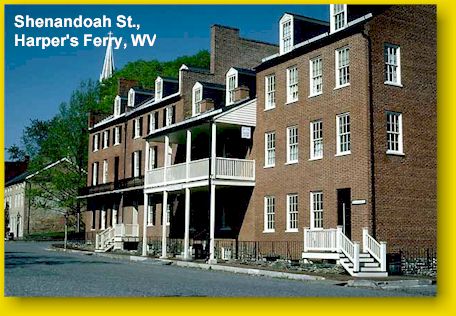 In the east I have been an avid Civil War reenactor for years (my web site as "Jonah Begone" can be accessed by clicking here), and appreciate that the subject of authenticity comes up frequently. In fact, it's the end-all and be-all for reenactors. But few, if any, reenactors actually examine what is authentic for them, based on what they grew up with. Sure, Civil War soldiers did not, as a rule, grow long sideburns in the manner depicted by illustrators during the 1961-1965 centennial. (The existing photographs do not bear this out.) But that's what I was used to seeing as a kid and to me, deep down inside where I'd never admit it to my reenacting friends, that's what looks authentic.
In the east I have been an avid Civil War reenactor for years (my web site as "Jonah Begone" can be accessed by clicking here), and appreciate that the subject of authenticity comes up frequently. In fact, it's the end-all and be-all for reenactors. But few, if any, reenactors actually examine what is authentic for them, based on what they grew up with. Sure, Civil War soldiers did not, as a rule, grow long sideburns in the manner depicted by illustrators during the 1961-1965 centennial. (The existing photographs do not bear this out.) But that's what I was used to seeing as a kid and to me, deep down inside where I'd never admit it to my reenacting friends, that's what looks authentic.
Sure, I like looking at the windmill in Burke, nowadays, and reflecting about how tranquil bygone days on the farm must have been. But a part of me wishes that the thing was lined in neon tubes.
Addendum from September 2002: Me, my wife and three kids drove to Orlando, Florida to visit Disney World last month; we spent a day at EPCOT, a day at the Magic Kingdom and a day at the Disney-MGM Studios park - we had a great time! As we were walking down the Hollywood section of the Disney-MGM Studios park, looking at the familiar architecture, my wife called my attention to the fact that we were doing a reverse of the Harper's Ferry experience I described above. In other words, this time we were looking at the Disney version of real buildings, signs and landmarks that we were very familiar with, having grown up in Los Angeles. (One building looked like the Max Factor building just off of Sunset Blvd., the "Crossroads of the World" building was reproduced, etc.) It was an odd feeling, and caused me, once again, to wonder, What is real and what is fake? And which do I prefer?
Doing a little Internet research on what happened to the Farm House, I got this information from a helpful Buena Park, CA reference librarian (support your local library!):
Dear Mr. Clark:
Thank you for you inquiry about Arnold's Farm House Restaurant, which was located on the corner of Manchester Blvd. and Stanton Avenue in Buena Park. I learned by asking my long-time-resident neighbor, that the restaurant actually started out as a real farm house some time earlier in the 20th Century. She thinks that approximately 1950, it was turned into a restaurant to serve travelers taking Manchester Blvd. from Los Angeles to San Diego. (This was before the Santa Ana Freeway, I-5, was built in the late 1950's). The restaurant served many Knott's Berry Farm visitors as well until the mid-or-late 1980's. It was at this time that it closed and was demolished. [I recall that it was built in the year of my birth, 1956. I last ate there with my in-laws in 1988. - Wes]
It was a family-run operation, and it's possible that they didn't care to continue on. I located an article in the Los Angeles Times, Orange County Edition that talked about a noteworthy part of the restaurant. In the Orange County Life section, page 9-1, author Randy Lewis talked about the use of neon signs in and around Los Angeles, pointing out neon's decline and more recent resurgence. One paragraph that I quote here (the only one making reference to the Farm House) said:
"As with other remnants of the past, much neon, despite the resurgence, is giving way to the wrecking ball. One of the oldest, most widely seen and most elaborate neon signs in Orange County--the windmill tower for Arnold's Farm House and the Buttery restaurants in Buena Park--is no longer functional. Both restaurants have been demolished for redevelopment, and the fate of the windmill, which still stands, unlit, is uncertain."
The windmill was never re-built. It was finally demolished about 1995 or 1996 so that the entire site on which the restaurant stood could be turned into a parking area and storage lot for several new car dealerships that are being built in the 1990's along Manchester Blvd. Arnold's Farm House Restaurant now lives on only in memory.
Bruce Pasarow, Reference Librarian
Buena Park Library District
More information about the Arnold family and the Farm House, in an e-mail from a reader:
3/23/00
For additional information about the Farm House, contact Mike Johnson at Arnold's Restaurant, Atlantic and Bixby, Long Beach. His father, Ray Johnson, worked at and later bought the Farm House, as well as the citified version of same in Long Beach, originally Arnold's Town House, now Arnold's Restaurant. Mike recently took over ownership and operation of Arnold's from Ray. He can provide insight into the Farm House and how to contact his father. By the way, The Buttery, which was across the street from the Farm House, was the more upscale of the two (a sit-down and service as opposed to cafeteria) and the more upscale restaurant at the time in North Orange County area. I remember as a youngster eating at the Farm House and ordering French fries, which were 30 cents an order. Ray, working behind the counter, counted and scooped up onto my plate six fries, the most expensive fries I ever had at 5 cents each. A Toyota dealership now sits on the land occupied by both the Farm House and the Buttery. People remembering the food served up at The Farm House can find their same favorites at Arnold's in Long Beach.
Robert Borsum
Clifton's Cafeteria
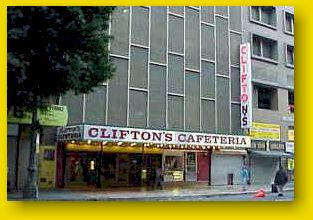 Also, I found this on the Internet. Clifton's still exists: "Affixed to a market place of stores on South Broadway is this L.A. flashback eatery. Penetrating the entrance you are transported into a burley redwood forest replete with stony waterfall. The standing timber filled interior reposes against red-green wallpaper and rocky flooring. Sequestered seating can be had inside the manicured thickets that encompass redwood tables and chairs. Roast beef and turkey are favorites in this soothing National Park styled cafeteria. Clifton's Brookdale Cafeteria, 648 South Broadway, Los Angeles, CA (Near West Seventh Street) Phone: 213-627-1673"
Also, I found this on the Internet. Clifton's still exists: "Affixed to a market place of stores on South Broadway is this L.A. flashback eatery. Penetrating the entrance you are transported into a burley redwood forest replete with stony waterfall. The standing timber filled interior reposes against red-green wallpaper and rocky flooring. Sequestered seating can be had inside the manicured thickets that encompass redwood tables and chairs. Roast beef and turkey are favorites in this soothing National Park styled cafeteria. Clifton's Brookdale Cafeteria, 648 South Broadway, Los Angeles, CA (Near West Seventh Street) Phone: 213-627-1673"
They have a web site: cliftonscafeteria.com
I found some old postcards of Clifton's on e-Bay:
"Melody Ledge"
"Forest Glen"
"Fireplace"
"Limeade Springs"
The Chapel in the Woods
Pretty elaborate, huh?
Apparently there was a "South Seas" Clifton's. Click here for an old postcard image. My Dad would have loved this...
While I was reading "On the Road" by Jack Kerouac, I came across this, in an account about Los Angeles: "Terry and I ate in a cafeteria downtown which was decorated to look like a grotto, with metal tits spurting everywhere and great impersonal stone buttockses belonging to deities and soapy Neptune. People ate lugubrious meals around the waterfalls, their faces green with marine sorrow." Is this Clifton's, I wonder?
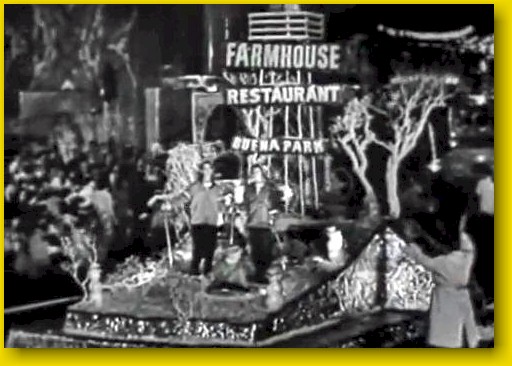
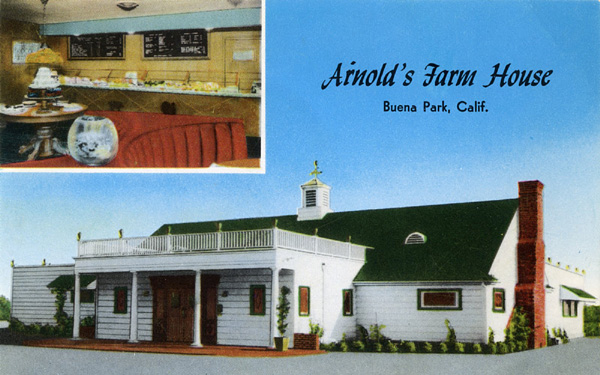
Lots more Farm House/Buttery/Arnold Family information (and a recipe!) on this Orange County Memories site.
Big scan of the neon windmill from a postcard I bought last time I ate there in 1988.
The windmill sign during the day.
Postcard front, Postcard rear.